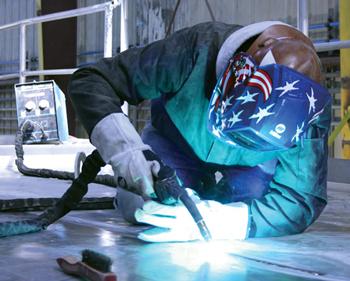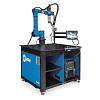National Sales Manager
- FMA
- The Fabricator
- FABTECH
- Canadian Metalworking
Categories
- Additive Manufacturing
- Aluminum Welding
- Arc Welding
- Assembly and Joining
- Automation and Robotics
- Bending and Forming
- Consumables
- Cutting and Weld Prep
- Electric Vehicles
- En Español
- Finishing
- Hydroforming
- Laser Cutting
- Laser Welding
- Machining
- Manufacturing Software
- Materials Handling
- Metals/Materials
- Oxyfuel Cutting
- Plasma Cutting
- Power Tools
- Punching and Other Holemaking
- Roll Forming
- Safety
- Sawing
- Shearing
- Shop Management
- Testing and Measuring
- Tube and Pipe Fabrication
- Tube and Pipe Production
- Waterjet Cutting
Industry Directory
Webcasts
Podcasts
FAB 40
Advertise
Subscribe
Account Login
Search
Aluminum filler metals: What you should know about selection, storage, operation, and equipment
- By Brian Farkas
- April 5, 2013
- Article
- Consumables

From trailer fabrication to shipbuilding and aerospace applications, companies rely on aluminum for its versatility, its strength, and, in certain service environments, its corrosion resistance.
From trailer fabrication to shipbuilding and aerospace applications, companies rely on aluminum for its versatility, its strength, and, in certain service environments, its corrosion resistance. Aluminum, however, requires special attention during the welding process. Proper precleaning procedures, careful control of heat input, and the use of appropriate welding equipment all are critical. Proper filler metal selection is equally important.
The most common aluminum filler metals are 4043 and 5356 alloys, both of which are available in wires for gas metal arc welding (GMAW) and cut-lengths (often called filler rods) for gas tungsten arc welding (GTAW). Knowing the basics for selecting these alloys for a given application, as well as the characteristics of each and their welding requirements, is critical to obtaining the best results. Here are some guidelines to assist you.
Making the Selection
In more than 85 percent of aluminum applications, 4043 and 5356 filler metals are the appropriate alloys for the job. They also are the most readily available in the marketplace and the least expensive to purchase. But how do you choose between the two? First, ask yourself these five key questions:
- What is the aluminum base designation?
- Will the welded component be exposed to sustained elevated temperature?
- Will the weldment be subjected to postweld anodizing?
- Are shear strength, ductility, and toughness prime considerations?
- Is postweld heat treating necessary?
Based on your answers to these of questions, you can narrow down your. For example, a 4043 filler metal is suitable for applications that are subjected to long-term elevated temperatures (above 150 degrees F), or when you want to reduce the opportunity for termination and shrinkage cracking. This alloy also is good for reducing distortion on aluminum and achieving brighter welds, ones without smut (the fine, dark layer of alloying elements, mostly magnesium, that occurs when welding with 5356 alloys).
If you are welding 5XXX or 6XXX series aluminum that contains less than 2.5 percent magnesium, you can use either a 4043 or a 5356 filler metal. For 5XXX series aluminum containing more than 2.5 percent magnesium, use a 5356 filler metal. You can also use 5356 to achieve good anodized color matching; for applications requiring higher ductility and toughness (such as those subject to dynamic loading); and for applications requiring higher shear strength. You can also use 4043 filler metals for higher-shear-strength applications, but it takes three fillet passes with this alloy to achieve the shear strength of one pass using a 5356 filler metal.
General Characteristics
Like all filler metals, 4043 and 5356 alloys each have unique characteristics. 4043 alloys contain 5 percent silicon, which makes the weld pool quite fluid. But because of this fluidity, they require a higher voltage during the welding process than other aluminum filler metals. A good setting is about 25 V combined with a wire feed speed of 380 inches per minute (IPM) for a wire 0.047 inches in diameter, depending on the material thickness, joint configuration, and weld position.
The 5356 filler metals contain 5 percent magnesium, an amount that directly affects the manner in which this alloy welds. During GMAW, a 5356 wire operates at lower voltages and with higher wire feed speeds — depending, of course, on wire diameter and material thickness. As an example, a 0.047-in. wire requires approximately 23 V and a 410-IPM wire feed speed for optimal welding results. These welding parameters provide for the higher penetration sought in applications using this particular aluminum filler metal, such as structural. The higher wire feed speed and voltage also generate greater penetration and ensure better fusion at the weld’s throat.
Because of the lower voltage at which they operate, 5356 filler metals generate a crackling sound during welding. They also create a layer of smut that must be removed, and the welds tend to be rippled. Generally, 4043 wires (because of the higher voltage parameters) generate a buzzing sound when welded and create a weld with a smoother surface.
Both 4043 and 5356 operate with 100 percent argon shielding gas. Argon provides good arc initiation and stability. In some cases, however, you may consider adding helium to the mixture. Helium is a hotter gas, and adding it to a shielding gas mixture provides better penetration, particularly on thick aluminum. Helium, though, is quite expensive and does not provide as good arc stability as argon.
Proper Storage and Handling
Proper storage and handling are very important to protect filler metals from damage, and aluminum alloys are no exception. Regardless of whether you use 4043 or 5356 alloys, it is important to keep them in a clean, dry area with an ambient temperature similar to that of the welding cell. Moving them from a cold area to one at room temperature causes condensation on their surface and leads to poor weld quality.
After a shift, keep the filler metals in the weld cell so they can remain at the same temperature at which you will use them next. For GMAW, cover the spool with the plastic bag the wire shipped in or with another protective cover. You can keep GTAW cut-lengths in their original box to protect them against dirt and debris.
When handling the 4043 and 5356 alloys, remember to wear gloves to protect the filler metals from any moisture or oils on your hands.
Equipment
After selecting the proper aluminum filler metal and learning about its characteristics and storage and handling requirements, you need to be sure you have the right welding equipment to use with these alloys.
In the GMAW process, you must use a push-pull gun. These guns accommodate the softness of the 4043 and 5356 alloys by minimizing wire feeding issues and allowing you to weld at farther distances (even as much as 30 feet) from the wire feeder.
It also is important to use the proper drive rolls, inlet guides, and consumables when welding with aluminum wires. U-groove drive rolls prevent the wire from being pinched or compressed and help ensure proper wire feeding. Likewise, it is important to use nylon inlet guides and GMAW gun liners when welding with aluminum wire. Unlike metal components, nylon does not “shave” the wire as it feeds through from the wire feeder to the contact tip, so there is less opportunity for debris to build up inside the liner.
Also be sure to use a contact tip specifically designated for aluminum wire. These consumables typically have an A (for aluminum) stamped on them and are sized accordingly. For example, 4043 and 5356 wires are available in 0.047-in. diameters (as opposed to the standard 0.045-in. diameter of steel wires), so the corresponding bore on the contact tip for these wires is slightly oversized, allowing for smooth wire feeding and good arc stability.
For other aluminum wire diameters — 0.030, 0.035, and 0.62 in. — be certain to select a contact tip with a corresponding bore size. In all cases, doing so helps prevent issues with poor arc control and poor-quality welds.
About the Author
About the Publication
Related Companies
subscribe now

The Welder, formerly known as Practical Welding Today, is a showcase of the real people who make the products we use and work with every day. This magazine has served the welding community in North America well for more than 20 years.
start your free subscription- Stay connected from anywhere

Easily access valuable industry resources now with full access to the digital edition of The Fabricator.

Easily access valuable industry resources now with full access to the digital edition of The Welder.

Easily access valuable industry resources now with full access to the digital edition of The Tube and Pipe Journal.
- Podcasting
- Podcast:
- The Fabricator Podcast
- Published:
- 04/30/2024
- Running Time:
- 53:00
Seth Feldman of Iowa-based Wertzbaugher Services joins The Fabricator Podcast to offer his take as a Gen Zer...
- Trending Articles
Aluminum MIG wires offer smooth feeding, reduced tangling

The role of flux in submerged arc welding performance

Three ESAB welding machines win Red Dot Awards for product design

Power source added to cobot welding system for simplified automation

Torch made for welding thin, conductive sheet metal

- Industry Events
Pipe and Tube Conference
- May 21 - 22, 2024
- Omaha, NE
World-Class Roll Forming Workshop
- June 5 - 6, 2024
- Louisville, KY
Advanced Laser Application Workshop
- June 25 - 27, 2024
- Novi, MI
Precision Press Brake Certificate Course
- July 31 - August 1, 2024
- Elgin,


























